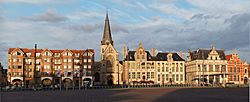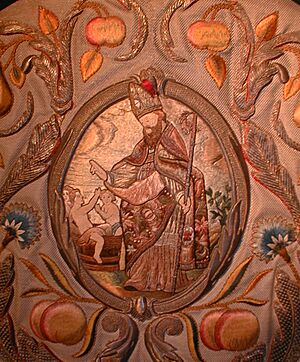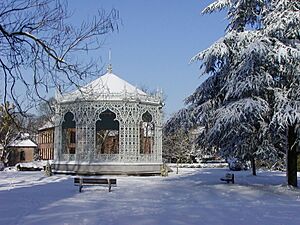Sint-Niklaas facts for kids
Quick facts for kids
Sint-Niklaas
Saint-Nicolas (French)
|
|||
|---|---|---|---|
 |
|||
|
|||
| Country | Belgium | ||
| Community | Flemish Community | ||
| Region | Flemish Region | ||
| Province | East Flanders | ||
| Arrondissement | Sint-Niklaas | ||
| Area | |||
| • Total | 83.80 km2 (32.36 sq mi) | ||
| Population
(2018-01-01)Lua error in Module:Wd at line 1575: attempt to index field 'wikibase' (a nil value).
|
|||
| • Total | Lua error in Module:Wd at line 1,575: attempt to index field 'wikibase' (a nil value). | ||
| Postal codes |
9100, 9111, 9112
|
||
| Area codes | 03 | ||
| Website | www.sint-niklaas.be | ||
Sint-Niklaas is a city and municipality in Belgium. It is located in the East Flanders province, which is part of the Flemish Region. The municipality includes the city of Sint-Niklaas itself, plus the towns of Belsele, Nieuwkerken-Waas, and Sinaai.
Sint-Niklaas is the main city of the Waasland area. This region stretches across the East Flanders and Antwerp provinces. The city is famous for having the largest market square in all of Belgium. This square once held the biggest Christmas tree and the largest Easter egg in Europe!
Contents
History of Sint-Niklaas
How Sint-Niklaas Began
Even though some very old traces of people have been found, the main local center during Roman times was a nearby town called Waasmunster. This was because Waasmunster was better located on the Durme river. The town of Belsele was mentioned in old papers as early as the 800s.
However, the story of Sint-Niklaas itself really started in 1217. At that time, the bishop of Tournai decided to build a church here. This church was named after Saint Nicholas. The new church area was connected to Tournai until the mid-1500s. But politically, Sint-Niklaas was part of the County of Flanders. Flanders was very powerful then, which helped the city grow quickly. It became the main administrative center of the region in 1241.
In 1248, a document showed that Margaret II, Countess of Flanders, gave more land to the Sint-Niklaas church area. She said this land should stay empty. This is why the central market square is so unusually large today!
From the 1300s to the 1600s
Sint-Niklaas never had walls around it. This meant it was easy for attackers to invade. In 1381, a fire destroyed parts of the city, and it was robbed. But Sint-Niklaas was in a great spot between Ghent and Antwerp, close to the Scheldt river. This helped it keep growing.
By 1513, Emperor Maximilian gave the city the right to hold a market every week. Around 1580, the Saint Nicholas church was badly damaged by groups who destroyed religious images. The 1600s were generally a good time for the city. Its economy grew, especially in making things from flax and wool. During this time, Sint-Niklaas also got new government buildings. Three groups of religious people (Oratorians, Franciscans, and Black Sisters) also settled there. They offered education, religious services, and medical care. On May 25, 1690, another big fire destroyed most of the city.
From the 1700s to Today
In the 1700s, the Austrian rulers were good for Sint-Niklaas. The city's main textile industry (making cloth) changed well with new machines. They started making cotton products in 1764. At the end of the century, the French Revolution brought both religious changes and new ways of governing to the city.
Napoleon visited Sint-Niklaas in 1803. He officially made it a city. The 1800s saw a general slowdown in the textile industry. Several new buildings were built, including the current city hall and the Onze-Lieve-Vrouwekerk (Church of Our Lady). After World War II, the textile industry faced problems. Today, the old center of Sint-Niklaas is mostly a place for shopping and services.
Important Places and Buildings
- The main Church of Saint Nicholas was built in the 1200s. It gave the city its name. After being badly damaged in the 1500s, its inside was rebuilt in the Baroque style.
- St. Joseph Minor Seminary is a Catholic school.
- The Onze-Lieve-Vrouwekerk (Sint Niklaas was built in the 1800s. It is famous for its Byzantine-style inside. It also has a 6-meter tall statue of Our Lady on top, covered in fine gold.
- The Town Hall is built in a Gothic revival style. It was built after the old hall burned down.
- The market square is the largest in Belgium. It was created by Margaret II, Countess of Flanders.
- The Gerardus Mercator Museum tells the story of cartography (map-making). The museum also has two original globes that belonged to the famous mapmaker.
- Other churches and museums include: Saint Joseph, Christ the King, Saloons of Fine Arts, and Zwijgershoek.
- The Huis Janssens is also an important building.
Events in Sint-Niklaas
- Every first weekend of September, Sint-Niklaas holds an international balloon meeting called "Vredesfeesten." There is also a three-day music festival called "Villa Pace."
- During the last week of the year, Sint-Niklaas hosts the Flanders Volley Gala. This is an international volleyball tournament.
- The city has seven processional giants. These are big figures carried in parades. They include Janneken, Mieke, Sinterklaas and Zwarte Piet, and the three Magi: Caspar, Melchior, and Balthasar.
Getting Around Sint-Niklaas
Sint-Niklaas is located on an important route between Ghent and Antwerp. This means it has great connections by train and car. The E17, one of Belgium's busiest highways, goes past the city. The N16 road leads to Mechelen and Brussels.
Trains leave every half-hour to Ghent and Antwerp. They leave hourly to Brussels, Mechelen, and Leuven from the new train station. The city also has many bus lines for both local and regional travel. In the city's main streets, buses drive in special lanes.
Sint-Niklaas was named the "Most Pedestrian Friendly City" in Flanders. This happened after its central Market area was made new again.
Mayors of Sint-Niklaas
Here are the mayors of Sint-Niklaas since the end of World War II:
- Henri Heyman (1933–1946)
- Romain De Vidts (1947–1962)
- Frantz Van Dorpe
- Paul De Vidts (1977–1988)
- Lieven Lenaerts (1995–1996)
- Jef Foubert (1997–2000)
- Freddy Willockx (1989–1994 and 2001 - June 2010)
- Christel Geerts, the first female mayor of Sint-Niklaas (July 2010 - 2012)
- Lieven Dehandschutter (2013 - present)
Famous People from Sint-Niklaas
- Alex Callier and Raymond Geerts, musicians from the band Hooverphonic
- Philip Coppens, author (1971–2012)
- Maurits Coppieters, politician (1920–2005)
- August de Maere, engineer who helped create the Zeebrugge Port (1802–1885)
- Martin De Prycker, engineer and CEO of Barco (born 1955)
- Els de Schepper, Flemish actress, comedian, and writer (born 1965)
- Sean Dhondt, TV presenter and lead singer of 'Nailpin' (born 1984)
- Ilyo Hansen, author (born 1966)
- Gustaaf Joos, cardinal
- Tom Lanoye, author (born 1958)
- Sven Maes, DJ (born 1973)
- Daniël Ost, florist (born 1955)
- Luis Siret, archaeologist and illustrator (1869–1934)
- Marc Sleen, comics artist (1922–2016)
- Woodie Smalls, rapper (born 1996)
- Paul Snoek, poet (1933–1981)
- Tom Steels, road cyclist (born 1971)
- Antoon Stillemans, bishop of Ghent (1832-1916)
- Edgar Tinel, composer, born in Sinaai (1854–1912)
- Marc Vael, computer scientist (born 1967)
- Wouter Van Bellingen, politician (born 1972)
- Sandrine Van Handenhoven, artist (born 1984)
- Henri Van Severen, gold embroiderer
- Anton van Wilderode, poet (1918–1998)
- Angelo Vermeulen, visual artist (born 1971)
- Yari Verschaeren, footballer (born 2001)
- Lisa Verschueren, gymnast (born 1995)
- Jan Vertonghen, footballer (born 1987)
- Erik Wijmeersch, athlete (born 1970)
Sint-Niklaas Around the World
Sint-Niklaas has "twin town" or "sister city" relationships with several cities around the world. This means they share cultural ties and friendly connections.
See also
 In Spanish: Sint-Niklaas para niños
In Spanish: Sint-Niklaas para niños









